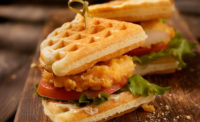How to solve the breading and batter riddle
The popularity of both traditional and health-oriented proteins requires a juggling act by meat and poultry merchandisers.

Developing and marketing meat and poultry with breading or batter can be a double-edged sword.
Merchandisers seeking to maximize sales face the burden of appealing to two distinct shopper groups: those who seek traditional selections; and the growing base of wellness-focused shoppers. It is a tricky situation. Despite a greater emphasis on better-for-you eating, conventional options remain dominant.
“Even with a greater interest in healthier eating, it’s comfort food and proven classics that continue to drive strong sales of proteins with breading and batter at retail and foodservice locations,” says Anne-Marie Roerink, principal at 210 Analytics, a San Antonio-based market research and marketing strategies firm and preparer of The Power of Meat 2021 report. “From the start of the pandemic, we saw comfort foods do very well, and with sports and entertainment back on, chicken wings quickly made their way back on menu to the point of being hard to source despite significant inflation.”
The stronger shopper interest in fried chicken containing breading and/or batter, meanwhile, is helping to fuel the chicken sandwich wars among the major fast-food operators. In January, Louisville, Ky-based KFC Corp. launched the new KFC Chicken Sandwich, which it describes as being a double-breaded extra-crispy chicken breast filet. The company notes the rollout followed a test in which sales were twice that of expectations.
Other 2021 launches include Chicago-based McDonald’s Corp.’s Crispy Chicken Sandwich; Miami-based Burger King Corp.’s hand-breaded Ch’King chicken sandwich; Atlanta-based Chick-fil-A Inc.’s Spicy Chicken Sandwich; and Miami-based Popeyes Louisiana Kitchen Inc.’s Chicken Nuggets which are hand-battered and breaded in buttermilk.
No end in sight
The demand for such products will likely be ongoing, says Russell Zwanka, associate professor in food marketing, at Western Michigan University, in Kalamazoo. He notes the chicken sandwich battle “sees no abatement in sight. KFC’s new chicken sandwich is performing as well as McDonald’s and Popeyes’, and Chick-fil-A never seems to take a hit.”
“Fried chicken sandwiches are not only prevalent but are increasingly so,” agrees Maeve Webster, president of Menu Matters, an Arlington, Vt.-based food industry consulting firm. “These are incredibly on-trend and are likely to remain so for some time. “
She notes fried chicken sandwiches and fried chicken, in general, are two of the most popular meat and poultry items containing breading and batter. Iterations of fried chicken from around the globe, including katsu and karaage, “are beginning to pick up steam. Chicken and waffles had a moment a few years ago and continue to be popular but have certainly been eclipsed by fried chicken sandwiches.”
Katsu is a Japanese dish typically consisting of breaded chicken or pork cutlets, while karaage is a Japanese cooking technique in which foods, frequently chicken, are deep-fried in oil.
“These items are solidly indulgent and leaning into indulgence still works, particularly heading into the winter and holiday months,” Webster says.
Breaded and battered pork and beef options, however, are far less common and interest in such dishes is declining as many consumers view such selections as “old fashioned” and “extremely unhealthy,” she says.
Despite the popularity of fried chicken, consumer health concerns are limiting sales of other fried proteins, analysts say. A 2019 U.S. study published in The BMJ, a peer-reviewed medical trade journal published by the British Medical Association, for instance, found that eating one or more servings of fried chicken a day was linked to a 13 percent higher risk of death from any cause and a 12 percent higher risk of heart-related death compared with no fried food. The study notes that “up to a third of North American adults have fast-food every day, and previous studies have suggested that a greater intake of fried food is associated with a higher risk of type 2 diabetes and heart disease.”
While the research focused on postmenopausal women, the study states that “reducing the consumption of fried foods, especially fried chicken and fried fish/shellfish, may have clinically meaningful impact across the public health spectrum.”
A previous investigation by Harvard University found that fried foods can increase the risk of heart disease by as much as 68 percent. The researchers, who followed the diets of 15,300 doctors as part of the Physician’s Health Study for about three years, also noted that those who ate fried foods up to three times a week saw an 18 percent increased risk for heart disease. The investigation found that risk rises to 25 percent if fried foods are eaten four to six times in a week, and up to 68 percent if eaten seven or more times in a week.
A health halo still pays dividends
As a result of such findings, more merchandisers are emphasizing recipes with lighter, healthier batters such as tempura, or lighter breading, Webster says. “Many consumers focused on healthful eating are likely to avoid these formats regardless,” she says.
Nevertheless, Webster notes that if meat or poultry with breading or batter can leverage a bit of a healthy halo by being lighter or incorporating functional ingredients such as herbs, “then it may create a more permissive indulgence that expands the potential market to a degree.”
Consumers meanwhile can create breaded items with less fat, including chicken wings, chicken fried steaks, and chicken cordon bleu, by using air fryers, Roerink says, adding that incorporating cauliflower for breading helps make selections suitable for lower-carbohydrate diets.
“We don’t need to make the full offering better for you, but having options is important in today’s market,” she says. “The innovation we’re seeing in the product itself and the preparation method opens doors for more health-focused consumers.”
That is important as 28 percent of meat shoppers report they put a lot of effort into making nutritious and healthful choices when purchasing meat and poultry. An additional 43 percent give it some effort, according to The Power of Meat 2021 report. The Arlington, Va.-based Food Marketing Institute (FMI) and the Washington, D.C.-based Foundation for Meat & Poultry Research & Education are publishers of the report.
Despite such a wellness focus, there still are possibilities for merchandisers to also expand the sale of items with breading and batter. That includes carrying the optimal selections in each outlet as the most popular items vary by region, Roerink says. Selections may include breaded pork tenderloins, chicken fried steak, schnitzel, chicken Milanese, country fried steak, and chicken wings.
“Retailers and restaurateurs have a nice opportunity in leveraging the different cuisines that use breaded items,” she says. “As both retailers and foodservice are contracting their total assortment and menus, limited-time offers will take on a greater role and that’s where breaded items can make for something different from the same old.”
In addition, retailers can help boost category interest by merchandising the meal components to create recipes with breading and batter together in stores or online, Roerink says.
Looking for a reprint of this article?
From high-res PDFs to custom plaques, order your copy today!










